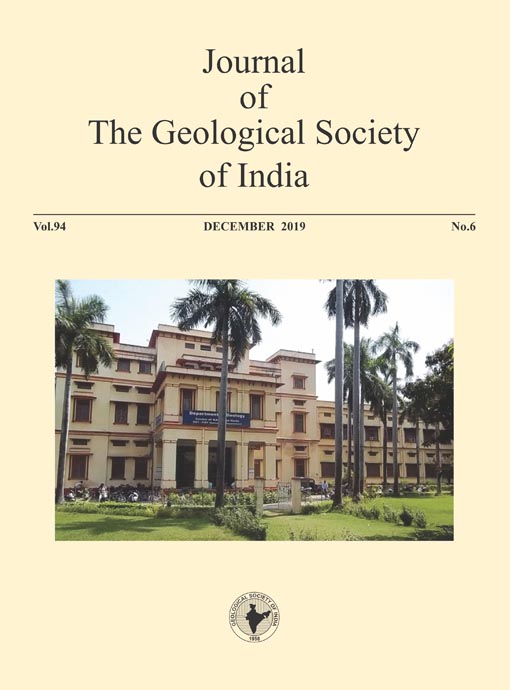Polycyclic Aromatic Hydrocarbons in Permian Coals of India: Source and Significance
DOI:
https://doi.org/10.1007/s12594-019-1363-xKeywords:
No Keywords.Abstract
The organic matter entrapped in the sediments often retain their molecular structures for millions of years. These structures hold important clues to the origin, precursors and proxies for the sedimentary environment. The investigation on the Permian coals reveal pyrene, benzo[a] anthracene, fluoranthene, indeno [1,2,3-cd] pyrene, chrysene, triphenylene, benzo[a] pyrene, benzo[e] pyrene, perylene, benzo[ghi] perylene and coronene which offer a window to the geological episodes of the past. There are two categories of PAH in the sediments, one formed from biological molecules through diagenetic process and the second class formed due to the effect of heat and fire. PAH such as pyrene, benzo[a] anthracene, fluoranthene, indeno[1,2,3-cd] pyrene, benzo[a] pyrene, coronene and chrysene, are product of vegetation fire, these pyrogenic products may have been introduced into the paleomire by the riverine channels. The global fire in the end of Permian is well recorded in geological history which was followed by Permian–Triassic P/T mass extinction. These PAH possibly represent the vegetation fire during the Permian. The PAH are also environmentally sensitive as they are known to create health hazards causing cancer to humans. Therefore, coal extraction and utilization pose a major challenge in coal handling plants, thermal power plants, metallurgical industries and other coal based industries.Downloads
Metrics
Issue
Section
Downloads
Published
How to Cite
References
Blumer, M. and Youngblood, W.W. (1975) Polycyclic aromatic hydrocarbons in soils and recent sediments. Science, v.188, pp.53-55.
Borrego, A.G., Blanco, C.G. and Puttmann, W. (1997) Geochemical significance of aromatic hydrocarbon distribution in the bitumens of the Puertollano oil shales, Spain. Org. Geochem., v.26, pp.219-228.
Brown, G. and Maher, W. (1992) The occurrence, distribution and sources of polycyclic aromatic-hydrocarbons in the sediments of the Georges river estuary, Australia. Org. Geochem., v.18, pp.201-221.
Casshyap, S.M. and Tewari, R.C. (1984) Fluvial models of the Lower Permian Coal measures of Son-Mahanadi and Koel-Damodar basins, India, In: Rahmani, R.A. and Flores, R.M. (eds) - Coal and Coal Bearing Sediments, Spec. Publ. No.7, Int. Assoc. Sedimentologists, pp.77-103.
Giger, W. and Schaffner, C. (1978) Determination of polycyclic aromatic - hydrocarbons in environment by glass capillary gas chromatography. Analyt. Chem., v.50, pp.243-249.
Grice, K., Backhouse, J., Alexander, R., Marshall, N. and Logan, G.A. (2005) Correlating terrestrial signatures from biomarker distributions, ä13C, and palynology in fluvio-deltaic deposits from NW Australia (Triassic- Jurassic). Org. Geochem., v.36, pp.1347-1358.
Grice, K., Lu, H., Atahan, P., Asif, M., Hallmann, C., Greenwood, P., Maslen, E., Tulipani, S., Williford, K. and Dodson, J. (2009) New insights into the origin of perylene in geological samples. Geochim. et Cosmochim. Acta, v.73, pp.6531-6543.
Grice, K., Nabbefeld, B. and Maslen, E. (2007) Source and significance of selected polycyclic aromatic hydrocarbons in sediments (Hovea-3 well, Perth Basin, Western Australia) spanning the Permian-Triassic boundary. Org. Geochem., v.38, pp.1795-1803.
Jiang, C., Alexander, R., Kagi, R.I. and Murray, A.P. (1998) Polycyclic aromatic hydrocarbons in ancient sediments and their relationships to palaeoclimate. Org. Geochem., v.29, pp.1721-1735.
Jiang, C., Alexander, R., Kagi, R.I. and Murray, A.P. (2000) Origin of perylene in ancient sediments and its geological significance. Org. Geochem., v.31, pp.1545-1559.
Kawka, O.E. and Simoneit, E.R.T. (1990) Polycyclic aromatic hydrocarbons in hydrothermal petroleums from the Guaymas Basin spreading center. Appl. Geochem., v.5, pp.17-27.
Killops, S. and Massoud, M.S. (1992). Polycyclic aromatic hydrocarbons of pyrolytic origin in ancient sediments: Evidence for Jurassic vegetation fires. Org. Geochem., v.18. pp.1-7.
Laflamme, E. R. and Hites, A. R. (1978) The global distribution of polycyclic aromatic hydrocarbons in recent sediments. Geochim. Cosmochim. Acta, v.42, pp.289-303.
Lu, Man., Lu, YueHan., Ikejiri, Takehito., Hogancamp, Nicholas., Sun, Yongge., Wu, Qihang., Carroll, Richard., í‡emen, Ibrahim and Pashin, Jack (2019) Geochemical Evidence of First Forestation in the Southernmost Euramerica from Upper Devonian (Famennian) Black Shales. Scientific Reports, v.9, 7851 pp.1-9.
Murchison, D.G. and Raymond, C.A. (1989) Igneous activity and organic maturation in the midland valley of Scotland. Int. Jour. Coal Geol., v.14, pp.47-82.
Nabbefeld, B., Grice, K., Summons, R.E., Hays, L.E. and Cao, C. (2010) Significance of polycyclic aromatic hydrocarbons (PAHs) in Permian/Triassic boundary sections. Appl. Geochem., v.25, pp.1374-1382.
Naik A.S., Singh M.P., Volkmann, N., Singh, P.K., Mohanty, D. and Kumar, D. (2016) Petrographic characteristics & paleomires of Mand-Raigarh coals, Mahanadi Gondwana Basin, Chhattisgarh, India. Int. Jour. Coal Sci. & Technol., v.3(2), pp.165-183.
Philp, R.P. (1985) Fossil fuel biomarkers: applications and spectra. Methods in Geochemistry and Geophysics, vol. 23. Elsevier, 294p.
Raja Rao, C.S. (1982) Coalfields of India, Coal Resources of Tamil Nadu, Andhra Pradesh, Orissa and Maharashtra. Geol. Surv. India, Bull. Series A, v.45(2), pp.103.
Renzi, L. and Peirong, W. (1991) PAH in fossil fuels and their geochemical significance. Jour. Southeast Asian Earth Sci., v.5, pp.257-262.
Simoneit, B.R.T. and Fetzer, J.C. (1996) High molecular weight polycyclic aromatic hydrocarbons in hydrothermal petroleums from the Gulf of California and Northeast Pacific Ocean. Org. Geochem., v.24, pp.1065-1077.
Singh, Alok, K. (2016) Petrographic and Geochemical Characterization of Coal from Talcher Coalfield, Mahanadi Basin, India. Jour. Geol. Soc. India, v.87, pp.525-534.
Stout, S.A., Emsbo-Mattingly, S.D. (2008) Concentration and character of PAHs and other hydrocarbons in coals of varying rank-implications for environmental studies of soils and sediments containing particulate coal. Org. Geochem., v.39, pp.801-819.
Tsibart, A. and Gennadiev, A.N. (2013) Polycyclic aromatic hydrocarbons in soils: Sources, behavior, and indication significance (a review). Eurasian Soil Sci., v.46, pp.728-741.
Tulipani, S., Grice, K., Greenwood, P.F., Haines, P.W., Sauer, P.E., Schimmelmann, A., Summons, R.E., Foster, C.B., Böttcher, M.E., Playton, T. and Schwark, L. (2015) Changes of palaeoenvironmental conditions recorded in Late Devonian reef systems from the Canning Basin, Western Australia: a biomarker and stable isotope approach. Gondwana Res., v.28, pp.1500-1515.
Venkatesan, M.I. and Dahl, J. (1989) Organic geochemical evidence for global fires at the Cretaceous Tertiary boundary. Nature, v.338, pp.57-60.
Ward, P.D., Garrison, G., Botha, J., Buick, R., Erwin, D.H., Kirschvink, J.L., De Kock, M.O. and Smith, R. (2005) Abrupt land gradual extinction among land vertebrates in the Karoo Basin, South Africa. Sci., v.307, pp.709-714.

 Amiya Shankar Naik
Amiya Shankar Naik






